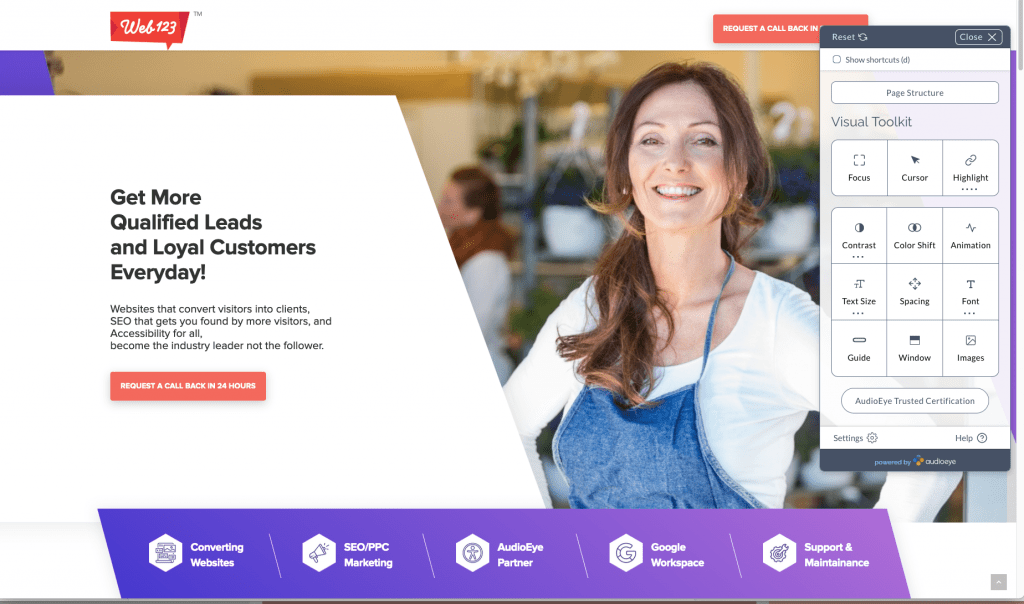Before you update or completely overhaul your website, it’s important to understand web content accessibility and what that means for your new website.
To address this for all organisations, the World Wide Web Consortium (W3C) created an internationally recognised standard called the Web Content Accessibility Guidelines (WCAG), which defines how to make web content more accessible to people with disabilities.
According to the guidelines, “Accessibility involves a wide range of disabilities, including visual, auditory, physical, speech, cognitive, language, learning, and neurological disabilities.”
The guidelines also aim to make content more usable by older people and improve usability across the board.
So, here is the essential information your organisation needs to know about the Web Content Accessibility Guidelines (WCAG) before you start your next web project.
What are Web Content Accessibility Guidelines (WCAG)?
Put simply, Web Content Accessibility Guidelines (WCAG) covers a wide range of recommendations for making web content more accessible.
Because these guidelines are used by a large audience, including web designers and developers, policy makers, purchasing agents, teachers, and students, it encompasses several layers of guidance to make content more accessible.
Which version of the Web Content Accessibility Guidelines is best for my organisation?
There are two versions of the web accessibility standard WCAG 2.0 and WCAG 2.1.
Choosing the right guidelines for your organisation will likely be determined by your policy position, time, and budget.
When picking the right guidelines, it’s important to note that WCAG 2.1 includes everything that’s in the 2.0 version, as well as extra guidelines for use of mobile devices.
It may be wise to consider the Web Content Accessibility Guidelines 2.1, knowing that you have covered both desktop and mobile web content accessibility considering that in November 2019, mobile traffic surpassed desktop traffic for the first time in history, and in the past 10 years, mobile has gone from just 2% of web page traffic to 52% of web page traffic.
What do the Web Content Accessibility standards include?
In order to meet the varying needs of the audience using the standards, several layers of guidance were created including:
1. Design Principles
Firstly, we have the four principles that provide the foundation for web content accessibility: Perceivable, Operable, Understandable, and Robust. This is also sometimes abbreviated to POUR.
2. Guidelines
Next we have guidelines. There are 12 guidelines, which provide the basic framework and goals that set a benchmark to make web content more accessible to users with different disabilities.
3. Success Criteria
For each of the guidelines, there is testable success criteria. This is so you can use the Web Content Accessibility Guidelines to ensure your website is compliant with the standard. This could be necessary in cases like design specifications, purchasing, regulation, and contractual agreements. Websites can be graded at one of three levels of compliance: A (lowest), AA, and AAA (highest). You can find out more about levels of conformance here.
4. Sufficient and Advisory Techniques
For each of the guidelines and success criteria, there’s also a wide variety of techniques. The techniques fall into two categories: those that help you meet the success criteria and those that are advisory.
What are the design principles?
As mentioned above, to ensure that your organisation meets the WCAG standard, it must follow the four design principles, abbreviated to POUR:
Perceivable:
Information and user interface have to be presented in a way that users can perceive.
Operable:
User interface and navigation must be operable.
Understandable:
Information and the operation of user interface must be understandable.
Robust:
Content must be robust enough that it can be interpreted by a range of users, including assistive technologies.
What is the success criteria?
There are three different implementation levels to ensure your website complies with the Web Content Accessibility Guidelines. These levels are known as Level A, AA, and AAA.
To determine the levels, the World Wide Web Consortium defined a list of three priorities to ensure a website was complying with the accessibility standards.
These priorities, as defined by the World Wide Web Consortium (W3C), are:
Priority 1:
A web content developer must satisfy this checkpoint. Otherwise, one or more groups will find it impossible to access information in the document. Satisfying this checkpoint is a basic requirement for some groups to be able to use web documents.
Priority 2:
A web content developer should satisfy this checkpoint. Otherwise, one or more groups will find it difficult to access information in the document. Satisfying this checkpoint will remove significant barriers to accessing web documents.
Priority 3:
A web content developer may address this checkpoint. Otherwise, one or more groups will find it somewhat difficult to access information in the document. Satisfying this checkpoint will improve access to web documents.
The (W3C) determined that if the first point was achieved, this would meet Level A. However, if both the first and second points were achieved, it meant the website met Level AA, and if all three were achieved, it would meet Level AAA.
In Australia, organisations are expected to meet Level AA compliance. This means that your organisation should aim to meet either WCAG 2.0 Level AA compliance; or WCAG 2.1 Level AA compliance.
What if your organisation’s current website doesn’t follow the guidelines?

Book your free Accessibility Compliance Audit with one of our friendly and knowledgeable Web123 website specialists to show you the exact steps to improve accessibility for all users.
To ensure your website complies with the Web Content Accessibility Guidelines (WCAG), book your free Accessibility Compliance Audit with one of our friendly and knowledgeable Web123 website specialists.
Call us on 1800 932 123 today or click here to send us an email via our Contact page.
